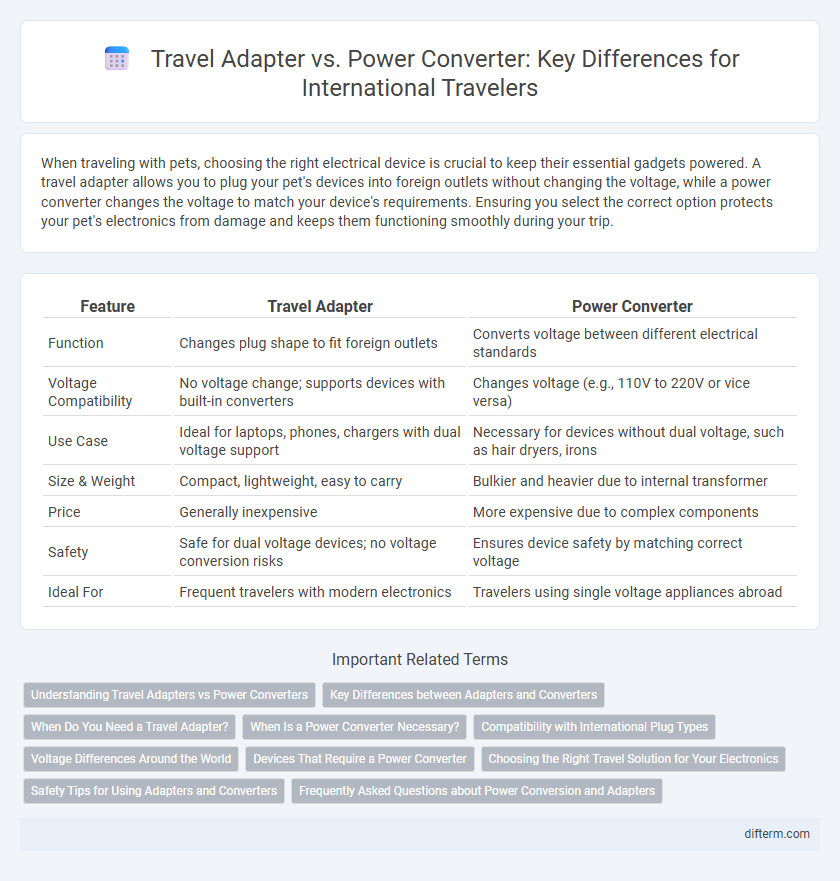When traveling with pets, choosing the right electrical device is crucial to keep their essential gadgets powered. A travel adapter allows you to plug your pet's devices into foreign outlets without changing the voltage, while a power converter changes the voltage to match your device's requirements. Ensuring you select the correct option protects your pet's electronics from damage and keeps them functioning smoothly during your trip.
Table of Comparison
| Feature | Travel Adapter | Power Converter |
|---|---|---|
| Function | Changes plug shape to fit foreign outlets | Converts voltage between different electrical standards |
| Voltage Compatibility | No voltage change; supports devices with built-in converters | Changes voltage (e.g., 110V to 220V or vice versa) |
| Use Case | Ideal for laptops, phones, chargers with dual voltage support | Necessary for devices without dual voltage, such as hair dryers, irons |
| Size & Weight | Compact, lightweight, easy to carry | Bulkier and heavier due to internal transformer |
| Price | Generally inexpensive | More expensive due to complex components |
| Safety | Safe for dual voltage devices; no voltage conversion risks | Ensures device safety by matching correct voltage |
| Ideal For | Frequent travelers with modern electronics | Travelers using single voltage appliances abroad |
Understanding Travel Adapters vs Power Converters
Travel adapters enable compatibility between different plug types by allowing devices to physically connect to foreign outlets without changing voltage. Power converters transform electrical current voltage to match the device's requirements, preventing damage from voltage differences in international travel. Using the correct device ensures safe and efficient charging of electronics worldwide.
Key Differences between Adapters and Converters
Travel adapters allow electronic devices to plug into foreign outlets by changing the plug shape without modifying voltage. Power converters transform voltage to match the device's electrical requirements, preventing damage from incompatible power sources. Understanding the voltage compatibility of your device and destination power standards is essential for selecting the correct travel accessory.
When Do You Need a Travel Adapter?
A travel adapter is necessary when your device's plug shape differs from the socket type in the destination country, allowing you to physically connect your charger or electronics. It does not convert voltage, so it's suitable for devices compatible with the local voltage range, typically 100-240V for laptops, smartphones, and cameras. Using a travel adapter ensures plug compatibility without altering electrical current, making it ideal for regions with different outlet designs but similar voltage standards.
When Is a Power Converter Necessary?
A power converter is necessary when your electronic devices are not compatible with the voltage of the destination country, typically when traveling from a 110-120V region, like the US, to a 220-240V region, such as Europe or Asia. Devices with heating elements or motorized components, like hairdryers or electric shavers, usually require a power converter to avoid damage or malfunction. Low-wattage electronics, such as phone chargers or laptops, often only need a travel adapter for plug compatibility, not voltage conversion.
Compatibility with International Plug Types
Travel adapters primarily enable connection compatibility between different international plug types, allowing devices to fit foreign sockets without altering electrical output. Power converters adjust voltage levels to match the local electricity supply, essential for devices not supporting dual voltage systems, but they do not change plug shapes. Understanding the distinction ensures travelers select the correct device to safely use electronics abroad without risking damage or incompatibility.
Voltage Differences Around the World
Travel adapters enable devices to plug into foreign outlets without altering the voltage, suitable for electronics with compatible voltage ranges (typically 100-240V). Power converters change the electrical voltage from one level to another, essential when traveling to regions with different voltages, such as from 110V North America to 220-240V Europe or Asia. Understanding the voltage differences around the world helps travelers protect their devices from damage and ensure safe, efficient charging during international trips.
Devices That Require a Power Converter
Devices that require a power converter typically include those with motors, transformers, or heating elements, such as hair dryers, electric shavers, and some laptops. These devices cannot simply rely on a travel adapter, which only changes plug shape without converting voltage. Using a power converter ensures safe operation by transforming local voltage to match the device's electrical requirements, preventing damage and ensuring optimal performance.
Choosing the Right Travel Solution for Your Electronics
Selecting the right travel solution for your electronics depends on understanding the difference between travel adapters and power converters. Travel adapters allow you to plug your devices into foreign outlets by adjusting the plug shape, while power converters modify the voltage to match your device's requirements, preventing damage from incompatible electricity. For sensitive electronics like laptops and cameras, investing in a reliable power converter ensures safety and functionality, whereas simpler devices often only need a travel adapter.
Safety Tips for Using Adapters and Converters
Ensure your travel adapter and power converter are certified by recognized safety standards such as UL or CE to prevent electrical hazards. Always verify the voltage and wattage compatibility of your devices with the adapter or converter to avoid overloading and potential fire risks. Use adapters and converters with built-in surge protection to safeguard your electronics from power surges while traveling abroad.
Frequently Asked Questions about Power Conversion and Adapters
Travel adapters enable compatibility between plug shapes of different countries, allowing devices to connect to foreign outlets without altering voltage. Power converters transform electrical voltage to match device requirements, essential for devices not supporting local voltage standards (e.g., 110V versus 220V). Common FAQs include identifying whether a device is dual voltage, choosing between an adapter only or a converter, and knowing when both are necessary for safe international device usage.
travel adapter vs power converter Infographic

 difterm.com
difterm.com